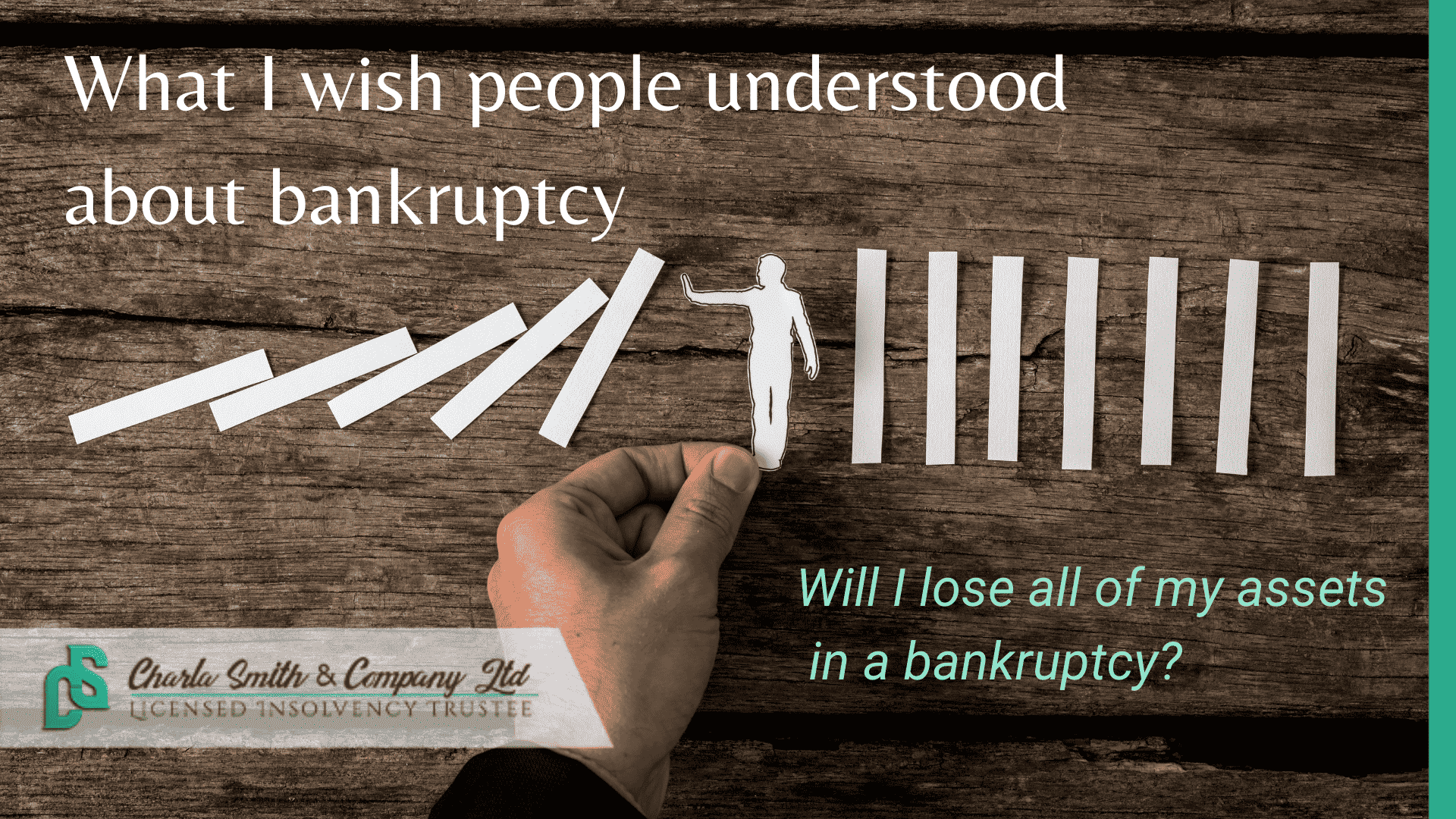
Everyone has heard of bankruptcy. But, as with anything a person may not have personally experienced, it’s easy to develop false assumptions about it based on tidbits of information heard in the news or from people you know. Unless a person has gotten up-close-and-personal with bankruptcy, there are some things they probably don’t know – things that might help if they or someone they care about are struggling with debt. As a Licensed Insolvency Trustee, one thing I wish people understood about bankruptcy is that people don’t usually lose all of their assets in bankruptcy. In fact, many people don’t lose any assets.
WHY DON'T PEOPLE ALWAYS LOSE ASSETS IN A BANKRUPTCY?
There's a common misconception that if someone becomes bankrupt, everything gets sold to pay creditors and they're left with nothing. Others are sometimes surprised when they see someone they know to be bankrupt continuing to go about their lives seemingly as usual. There can be a suspicion in these cases that the person is flouting the bankruptcy rules or that the system is somehow “rigged”.
The truth is, people often don't lose any of their assets in bankruptcy for one or more of the following reasons:
They filed a creditor proposal, not a bankruptcy
Sometimes, the media and others refer to any kind of financial restructuring as “bankruptcy”, which likely stems from the way the word is used in the United States. In Canada, “bankruptcy” is a very specific type of financial restructuring, a last resort. Licensed Insolvency Trustees can often assist people with a less drastic type of financial restructuring, called a Consumer Proposal. This is still a formal legal restructuring, and the laws relating to a Consumer Proposal are contained in the federal Bankruptcy and Insolvency Act, so sometimes people confuse this with bankruptcy. But there are some major differences between a bankruptcy and a Consumer Proposal.
One of the main differences is that individuals who file a Consumer Proposal are not required to turn over any of their assets as part of the process. Instead, they make a new legal agreement with their creditors to make payments into a proposal “fund”, which is then used to pay down some or all of the debt. Sometimes, part of the agreement is that the individual will sell certain assets to generate the money for the “fund”, but it's not a requirement. More often, if the individual has valuable assets that their creditors could have seized, they'll offer to pay the value of those assets into the fund over a period of time, such as monthly payments for five years. In that case, they keep the assets but their creditors still get to benefit from their value.
They don’t own any assets
People don’t often share a lot of information about their finances, especially if they are experiencing financial difficulty. So others might be surprised to find out that the house a person lives in or the car they drive is leased or belongs to a family member or the company they work for. In these cases, they don’t own the assets so there's nothing to turn over to the Trustee if they file a bankruptcy. As long as they can continue to honour their agreement with the owner, they can keep using the assets.
Their assets are fully encumbered by secured debt
Many people don’t realize that when a person files a bankruptcy, the bankruptcy does not deal with secured debt – debt that is owed to a creditor who has taken an asset as security for their debt. A common example of this is a home mortgage. Although the home may be owned by the inhabitant, the bank has registered on the home’s title as a secured creditor. This gives the bank the right to seize the asset and/or sell it to get paid back. Since secured creditors are left out of the bankruptcy system, they can continue to deal with the person by letting them continue making payments, or they can get paid by selling the asset.
People who file bankruptcy are more likely to have fully encumbered assets, meaning there's no value left in the asset after deducting what's owed to the secured creditor. In that case, the asset has no value for the Trustee, so it's left to the individual and the secured creditor to figure out what to do about the debt. Typically, as long as the individual can keep the secured creditor satisfied by continuing to make monthly payments, they can keep the asset.
Their assets are exempt
Each province in Canada has laws that make certain assets exempt from seizure by creditors, which means that the people owed money can’t take those assets or force an individual to sell them in order to get paid. The Trustee in a bankruptcy is subject to those same laws.
The reason for these exemptions is to allow the individual to keep enough to live on while they rebuild their financial lives. Without these exemptions, it would be much harder for bankrupt individuals to rebuild, and they'd be more likely to need to rely on social assistance programs in the aftermath of a bankruptcy filing.
In Alberta, the Civil Enforcement Act governs exempt assets which include:
- Up to $40,000 in equity (sale value minus secured debt) in a primary residence
- Up to $5,000 in value (or equity) in one vehicle
- Certain personal and household goods
- Most RRSP and RESP savings
- Certain tools of the trade for generating income
If the individual’s assets (or the value left after deducting secured debt on those assets) don't exceed the above limits, they likely won’t lose any of their assets in a bankruptcy.
They've made a deal with the Trustee to “buy it back”
Sometimes, it's important to the individual to keep assets that they're supposed to hand over to the Trustee. In that case, they can attempt to negotiate with the Trustee to keep the asset, by paying the Trustee for its value. Often, this involves assistance from family and/or payments to the Trustee over time. So even though the person may have previously paid for the item, they essentially pay for it again so that they don’t have to release it to the Trustee.
FIND OUT WHAT YOU CAN KEEP
In each of the above cases, assets that wouldn't have been available to be seized by creditors can be kept by the bankrupt individual in bankruptcy, while assets that would've been available to be seized by creditors are either seized by the Trustee or their value is paid over to the Trustee. So, in essence, bankruptcy doesn't change what can or cannot be kept. It's simply an orderly process for collecting all of the assets that would've otherwise been available and distributing them to creditors fairly.
Too many people delay coming to see a Licensed Insolvency Trustee due to fear over losing their assets. As a result, they often end up spending months, years or even decades struggling with their debt before they reach out for help. I wish people knew it didn’t have to be that way.
If you are struggling with debt and want to explore your options, Charla Smith & Company can help.
FREQUENTLY ASKED QUESTIONS
Q: How do I find out what assets I can keep?
There are several factors to consider to determine what you could keep in a bankruptcy. To be sure, the best way to find out is to contact a Licensed Insolvency Trustee for a free no-committment assessment.
Q: How do I find out whether bankruptcy is necessary or whether I'm eligibile for another option like a creditor proposal?
Check out our Consumer Proposal and Bankruptcy pages for information about these options and their pros and cons. For information about other options, check out our financial advice and information about community supports on our blog posts.
For more information or an opinion on which option is best for your specific circumstances, contact a Licensed Insolvency Trustee for a free no-committment assessment.
CHARLA SMITH & COMPANY LTD.

Let us help you get relief from the burden caused by your debt. As a Licensed Insolvency Trustee, Charla Smith & Company are highly trained and experienced in debt relief solutions, and we take great pride in identifying the option that's the best fit for your unique situation. From advice on talking to your creditors to consumer proposals to bankruptcy and everything in between, we’re here to answer questions, guide and advise you so you can take back control of your financial situation. Serving Calgary, AB and surrounding areas.
YOUR TRUSTED CHOICE FOR DEBT RELIEF
With our experience and our caring approach, we will help you find the best option for debt relief based on your unique situation - from advice on talking to your creditors to a consumer proposal or bankruptcy, and everything in between. We are here to lift the burden caused by overwhelming debt.
Contact us today at 1-403-899-3890 for a FREE, confidential, no-commitment meeting, and let us guide you to regaining your financial footing.
